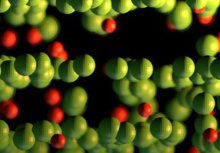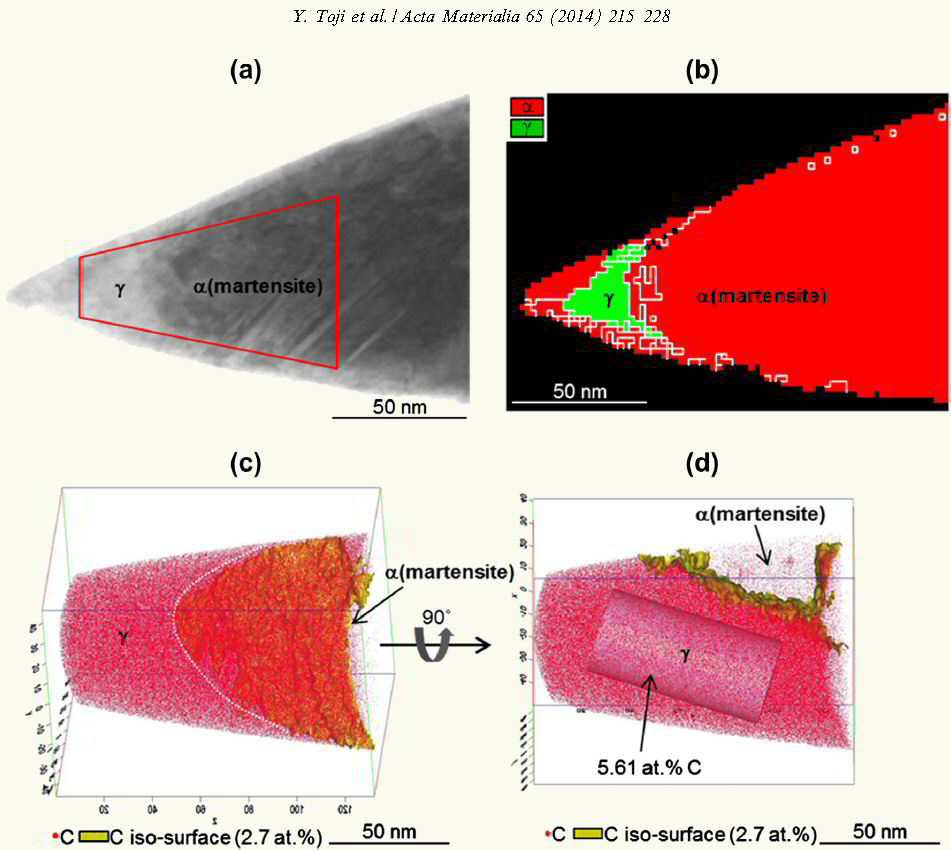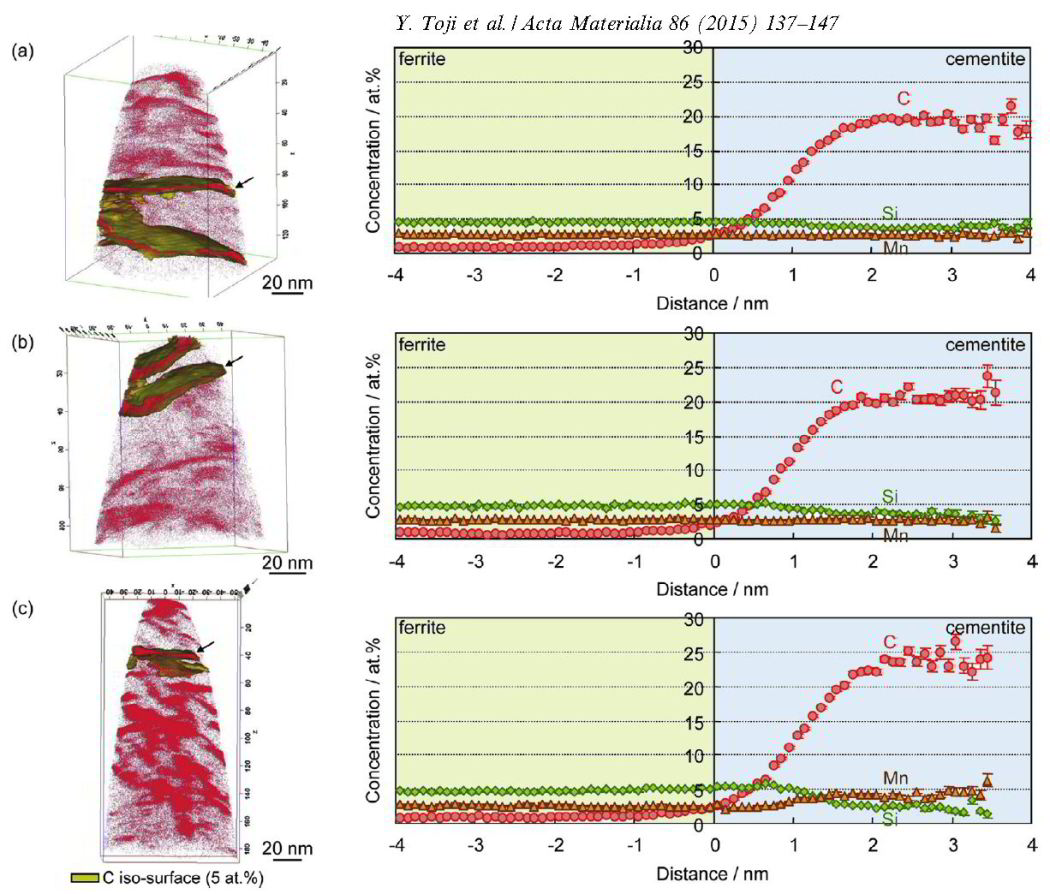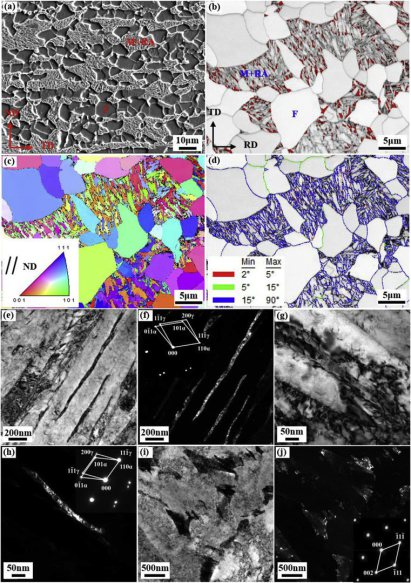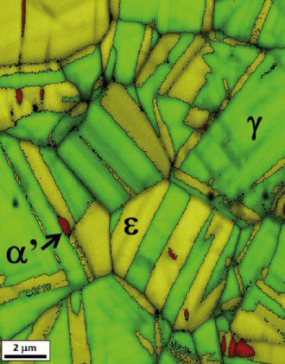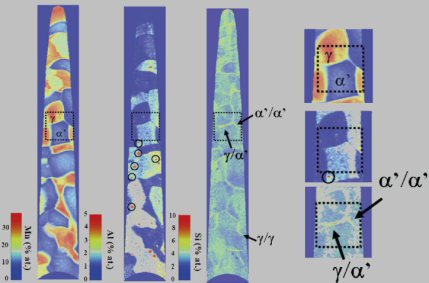Quench & Partitioning (QP) steels: Nanostructure and Atom Probe Tomography
Quench & Partitioning (QP) steels are characterized by an excellent balance of high tensile strength and good elongation with similar chemical compositions as
conventional TRIP steels. They are produced via the Q&P process which consists of a quenching and a partitioning step. In the quenching step, fully austenitized or
intercritically annealed steels are quenched to temperatures (referred to as the “quench temperature”) below the martensite start (Ms) temperature but above the martensite finish (Mf) temperature in
order to form a controlled volume fraction of martensite. The quenched steels are then held at the same or higher temperatures than the quench temperature during the subsequent partitioning
step. Austenite that prevails after quenching is considered to be stabilized through carbon partitioning from martensite into the
austenite during the partitioning treatment. The resultant microstructures of the steels mainly consist of tempered martensite and retained austenite so that a higher strength can be achieved as
compared to conventional TRIP steels.
Carbon partitioning between ferritic and austenitic phases is essential for all austenite stabilization phenomena in most advanced steels such as those encountered in the Q&P process. The
atomistic analysis of carbon partitioning in Q&P alloys is, however, challenging owing to the overlap of several competing phenomena during the partitioning step. It has
been suggested that the carbon partitioning from martensite into austenite is controlled by the constrained carbon equilibrium (CCE) criterion. This criterion aims at predicting the carbon
concentration in austenite under the condition that
(1) an identical carbon chemical potential exists in both ferrite (or martensite) and austenite;
and that
(2) the atomic balancing proceeds under the assumption that the interface between ferrite and austenite does not migrate.
Therefore, this model does not account for the volume expansion frequently observed during the partitioning step. Possible reasons to explain the volume expansion are the bainite transformation or the migration of martensite/austenite interface, in cases where the partitioning temperature is above the Ms temperature. The bainite transformation can also contribute to carbon enrichment into the remaining austenite if carbide precipitation is suppressed, for example, through the addition of Si. The migration of the martensite/austenite interface should also have some influence on carbon enrichment into austenite. Therefore, it is essential to separate the contributions to the carbon enrichment into austenite during the Q&P heat treatment caused by the carbon partitioning from martensite from that caused by the other possible mechanisms mentioned above.
Acta Materialia 65 (2014) 215-228
Yuki Toji, Hiroshi Matsuda, Michael Herbig, Pyuck-Pa Choi, Dierk Raabe
Atomic-scale analysis of carbon partitioning between martensite and austenite by atom probe tomography and correlative transmission electron microscopy
Acta Materialia 65 (2014) 215 carbon par[...]
PDF-Dokument [1.7 MB]
Carbon partitioning between ferritic and austenitic phases is essential for austenite stabilization in the most advanced steels such as those produced by the quenching and partitioning
(Q&P) process. The atomistic analysis of the carbon partitioning in Q&P alloys is, however, difficult owing to the simultaneous occurrence of bainite transformation, which can also
contribute to carbon enrichment into remaining austenite and hence overlap with the carbon partitioning from martensite into austenite. Therefore, we provide here a direct
atomic-scale evidence of carbon partitioning from martensite into austenite without the presence of bainite transformation. Carbon partitioning is investigated by means of atom probe tomography and
correlative transmission electron microscopy. A model steel (Fe–0.59 wt.% C (2.7 at.% C)–2.0 wt.% Si–2.9 wt.% Mn) with martensite finish temperature below room temperature was designed and
used in order to clearly separate the carbon partitioning between martensite and austenite from the bainite transformation. The steel was
austenitized at 900 °C, then water-quenched and tempered at 400 °C. Approximately 8 vol.% retained austenite existed in the as-quenched state. We confirmed by X-ray diffraction and dilatometry that
austenite decomposition via bainite transformation did not occur during tempering. No carbon enrichment in austenite was observed in the as-quenched specimen. On the other hand, clear
carbon enrichment in austenite was observed in the 400 °C tempered specimens with a carbon concentration inside the austenite of 5–8 at.%. The results hence quantitatively revealed carbon
partitioning from martensite to austenite, excluding bainite transformation during the Q&P heat treatment.
Yuki Toji, Goro Miyamoto and Dierk Raabe
Acta Materialia 86 (2015) 137-147
Carbon partitioning during quenching and partitioning heat treatment accompanied by carbide precipitation
Acta Materialia 86 (2015) 137 Toji carbo[...]
PDF-Dokument [1.8 MB]
Carbon partitioning from martensite into austenite in the quenching and partitioning (Q&P) process has been suggested to be controlled by the constrained carbon equilibrium (CCE) criterion. It defines an approach for predicting the carbon concentration in austenite under the condition that competing reactions such as carbide formation and bainite transformation are suppressed. Carbide precipitation in martensite is, however, often observed during the partitioning step, even in low-carbon steels as well as in high-carbon steels, even when containing a high amount of Si. Therefore, carbon partitioning from martensite into austenite is studied here, considering carbide precipitation in martensite. Carbon partitioning was investigated by means of a field-emission electron probe micro analysis (FE-EPMA) and atom probe tomography (APT), using 1.07 wt.% and 0.59 wt.% carbon steels with various martensite volume fractions. Carbon partitioning from martensite to austenite was clearly observed in all specimens, even though a considerable amount of carbide precipitated inside the martensite. The austenite carbon concentration after the partitioning step was not influenced by either the martensite volume fraction or the bulk carbon content. A modified model for predicting the austenite carbon concentration after the partitioning step was proposed to explain the experimental results by assuming carbon equilibria between austenite, ferrite and cementite under a constrained condition.
Carbon and strain partitioning in a quenched and partitioned steel containing ferrite
In this project we applied a hot rolling direct quenching and partitioning (HDQ&P) process to a low-C low-Si Al-added steel and obtained a Q&P steel containing 40 vol % of ferrite.
Microstructure characterization was then performed by means of SEM, EBSD, TEM and XRD. Atomic-scale compositional characterization of carbon
partitioning among the phases was carried out by atom probe tomography (APT). The carbon distribution in the retained austenite and near
the martensite/retained austenite interfaces was quantitatively analyzed to study its partitioning behavior. The macroscopic strain distribution evolution across the tensile sample surface
was investigated using macro digital image correlation (DIC) analysis. Combining these results with joint micro-DIC and EBSD analysis during quasi in-situ tensile testing, we investigated the strain partitioning among the different phases and the TRIP effect. Coupling of these results enabled us to reveal the relation among carbon partitioning, strain partitioning and the TRIP effect. The large blocky retained austenite with a side length of about 300-600 nm located near the ferrite/martensite (F/M) interfaces has
low stability and transforms to martensite during the early deformation stages, i.e. at average strain below 21%. The retained austenite films in the centers of the martensite regions are
more stable. The carbon distribution in both, the martensite and the retained austenite are inhomogeneous, with 0.5-2.0 at. % in the martensite and 4.0-7.5 at. % in the retained austenite.
Strong carbon concentration gradients of up to 1.1 at. %/nm were observed near the martensite/retained austenite interfaces. The large blocky retained austenite (300-600 nm in side length)
near the F/M interfaces has 1.5-2.0 at. % lower carbon content than that in the narrow retained austenite films (20-150 nm in thickness). The ferrite is soft and deforms prior to the
martensite. The strain distribution in ferrite and martensite is
inhomogeneous, varying by up to 20% within the same phase at an average strain of about 20%. Ferrite deformation is the main origin of ductility of the material. The balance between ferrite
fraction and martensite morphology controls the TRIP effect and its efficiency in reaching a suited combination of
strength and ductility. Reducing the ferrite volume fraction and softening the martensite by coarsening and polygonization can enhance the strain carried by the martensite, thus promoting more retained austenite in the martensite regions enabling a TRIP effect. The enhancement of the TRIP effect and the decrease of the strain
contrast between ferrite and martensite jointly optimize the micromechanical deformation compatibility of the adjacent phases, thus improving
the material's ductility.
Acta Materialia 165 (2019) 561
Acta 2019 Carbon strain QP steel with fe[...]
PDF-Dokument [6.7 MB]
Martensite to austenite reversion in a high-Mn steel: Partitioning- dependent two-stage kinetics revealed by atom probe tomography, in-situ magnetic measurements and simulation
In this project we study the austenite (g) reversion in a cold-rolled 17.6 wt.% Mn steel by means of dilatometry and in-situ magnetic measurements during slow continuous annealing. A splitting of
the gamma-reversion into two stages was observed to be a result of strong elemental partitioning between gamma and martensite during the low temperature stage between 390 and 575 "C. Atom
probe tomography (APT) results enable the characterization of the Mn-enriched reversed-g and the Mn-depleted remaining martensite. Because of its lower Mn content, the reversion of the
remaining a0-martensite into austenite takes place at a higher temperature range between 600 and 685 "C. APT results agree with partitioning predictions made by thermo-kinetic simulations
of the continuous annealing process. The critical composition for gamma-nucleation was predicted by thermodynamic calculations (Thermo-Calc) and a good agreement was
found with the APT data. Additional thermo-kinetic simulations were conducted to evaluate partitioning-governed g-growth during isothermal annealing at 500 "C and 600 "C. Si partitioning
to gamma was predicted by DICTRA and confirmed by APT. Si accumulates near the moving interface during gamma-growth and homogenizes over time. We used the chemical composition of the
remaining a0-martensite from APT data to calculate its Curie temperature (TCurie) and found good agreement with magnetic measurements. These results indicate that elemental partitioning
strongly influences not only gamma-reversion but also the TCurie of this steel. The results are important to better understand the thermodynamics and kinetics of austenite reversion for a wide
range of Mn containing steels and its effect on magnetic properties.
Acta Materialia 166 (2019) 178
Acta Mater 2019 Martensite-austenite rev[...]
PDF-Dokument [6.0 MB]
